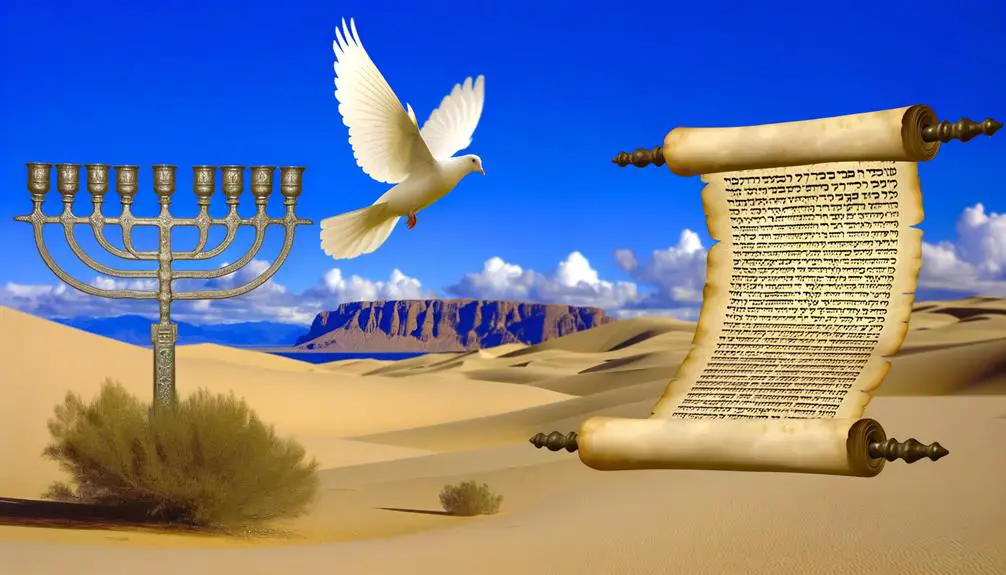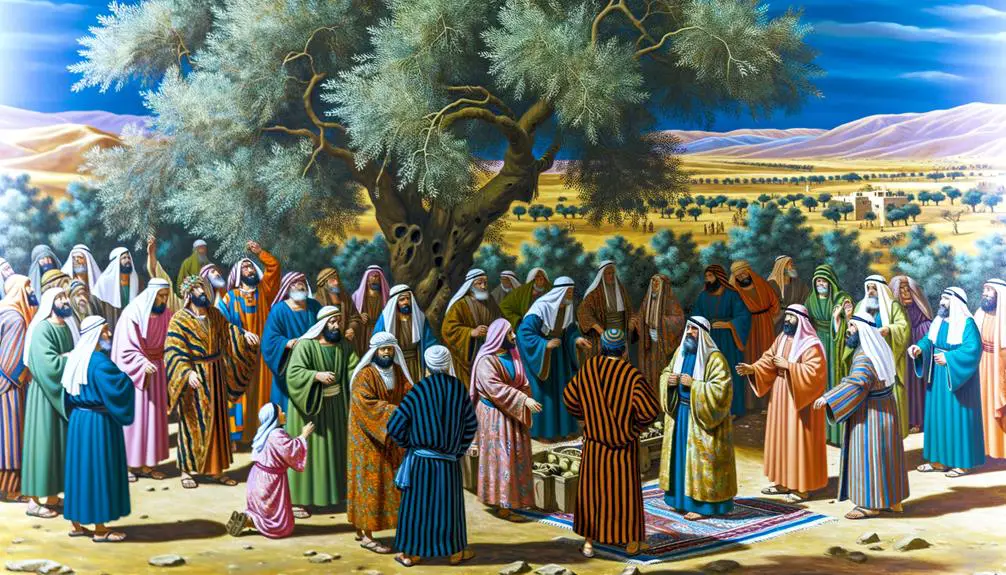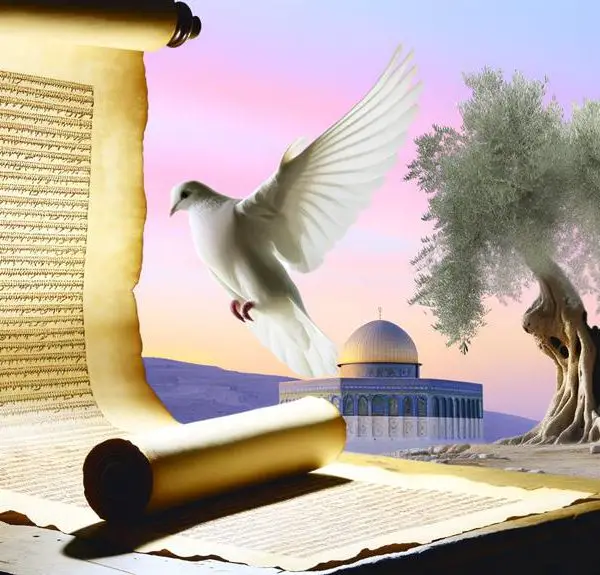Explore the profound significance of circumcision in the Bible, a symbol of covenant and renewal that transcends mere physicality.

Circumcised Meaning in the Bible
In the Bible, circumcision is a ritual that signifies a covenant between God and Abraham, marking a foundational aspect of your heritage if you're of Jewish descent. It symbolized both physical and spiritual purification, initially instituted as an enduring sign of belonging and obedience to God. Over time, its meaning evolved to emphasize spiritual purity rather than just physical. Paul, addressing the Gentiles, shifted the emphasis from a physical act to a metaphorical "circumcision of the heart," indicating spiritual renewal and a deepened relationship with the divine. Exploring further can offer deeper insights into its complex role throughout biblical history.
Key Takeaways
- Circumcision in the Bible symbolizes the covenant between God and Abraham, marking his descendants as God's chosen people.
- It represents spiritual purity and obedience to God's commandments, evolving from a physical to a spiritual interpretation.
- Paul redefined circumcision for Christians, emphasizing spiritual circumcision of the heart over physical rites.
- In Jewish tradition, circumcision occurs on the eighth day of a male infant's life, signifying entry into the religious community.
- The practice was debated in early Christianity, especially regarding its necessity for Gentile converts, leading to broader interpretations of faith and purity.
Origin of Biblical Circumcision

Circumcision, as introduced in the Bible, marks not only a physical alteration but also signifies a covenant between God and Abraham, serving as a foundational ritual for ancient Israelite identity. This practice, however, didn't originate in a vacuum. Historical practices and cultural influences from neighboring civilizations such as Egypt and Mesopotamia played significant roles in shaping this tradition. You'll find that in ancient Egypt, circumcision was performed as a rite of passage for young males entering adulthood, showcasing its deep roots in the region's societal norms.
Examining these cultural exchanges, it's evident that the Israelites, during their formative years, were heavily influenced by the prevailing customs of the Ancient Near East. The adaptation of circumcision by the Israelites likely served dual purposes: it was a means of aligning with common regional practices, thereby facilitating social integration, and it acted as a distinct marker of their unique covenant with God. This dual utility underscores the complexity of understanding ancient rituals, where spiritual meanings were often intertwined with pragmatic societal needs.
Analyzing these layers, you gain a deeper appreciation for how ancient traditions like circumcision were not merely isolated religious commands but were part of a broader tapestry of cultural and historical interactions.
Circumcision as Abraham's Covenant
In the biblical narrative, Abraham's adoption of circumcision transcends mere physical alteration; it symbolizes a profound covenant with God, distinguishing his lineage with a divine promise. This act wasn't just a bodily modification but a commitment that marked his descendants as God's chosen people. It's imperative to see this event as a pivotal moment not only in Abraham's life but also in the broader biblical story, where divine agreements shape human destiny.
From this covenant, several significant elements emerge:
- Divine Selection: Abraham's line through Isaac was chosen for a special relationship with God, setting the stage for future biblical narratives.
- Ishmael's Exclusion: Though Abraham's first son, Ishmael, was also circumcised, his eventual exclusion from this covenant highlights the selective nature of divine promises and introduces complex family dynamics.
- Hagar's Perspective: Often overlooked, Hagar's viewpoint provides a poignant insight into the struggles and repercussions of divine choices on lesser characters in these narratives.
You must appreciate how these elements contribute to the understanding of circumcision beyond its physical act. It becomes a symbol of chosenness, fraught with personal and communal implications, deeply woven into the fabric of biblical theology.
Physical and Spiritual Significance

As you explore the Biblical origins of circumcision, you'll find that this ritual is not merely a physical act but is imbued with profound spiritual implications. Symbolic meanings are extensively explored within scriptural texts, revealing layers of interpretation that connect physical actions to spiritual lessons. Today, modern religious practices continue to reflect these ancient interpretations, demonstrating the enduring significance of circumcision in both personal and communal religious identities.
Biblical Origins of Circumcision
When delving into the biblical origins of circumcision, it's important to understand that this ritual holds both physical and spiritual significance within the scriptures. Originating from divine commandments, the practice was not merely a physical act but a covenantal sign between God and His people, primarily seen in the Abrahamic covenant.
- Cultural influences: Circumcision distinguished the Israelites from surrounding nations, embedding a deep cultural identity.
- Health considerations: Although not the primary focus, health benefits such as hygiene might have played a role.
- Covenantal aspect: It was a physical manifestation of spiritual commitment and obedience to God.
Analyzing these components reveals how deeply intertwined physical actions and spiritual meanings were in ancient practices, reflecting a holistic approach to divine commands.
Symbolic Meanings Explored
Exploring the symbolic meanings of circumcision reveals a rich tapestry of physical and spiritual significance deeply embedded in biblical texts. You'll find that beyond its initial medical or tribal identity, circumcision in the Bible acts as a potent symbol of ritual purity and a sign of a covenant with God. This ritual not only marked a physical distinction but also signified a deeper, spiritual cleansing and readiness to follow divine commandments. Additionally, as tribes and cultures interacted, circumcision underwent cultural adaptation, reflecting changes in societal values and religious practices. This adaptability underscores its role in not only maintaining traditional religious identity but also in embracing an evolving theological landscape, where physical acts resonate with spiritual truths.
Modern Religious Practices
Many modern religious communities continue to observe circumcision, valuing it both for its physical purification and as a profound symbol of spiritual commitment. This practice, deeply rooted in historical traditions, has undergone various forms of ritual adaptation to align with contemporary ethical standards and medical advancements.
- Ritual Adaptation: Modifications in the procedure to enhance safety and reduce discomfort.
- Spiritual Significance: Reinforcement of covenant relationships and personal sacrifices in faith contexts.
- Contemporary Controversies: Debates over ethical implications and the autonomy of individuals subjected to the ritual.
These dynamics illustrate a complex interplay between tradition and modernity, compelling you to contemplate how ancient practices are recalibrated to resonate with current societal values and medical insights.
Circumcision in Jewish Tradition

Circumcision holds a central role in Jewish tradition, symbolizing the covenant between the Jewish people and God as first established with Abraham. The rite, known in Hebrew as Brit Milah, is not merely a physical act but a profound spiritual and communal ceremony, deeply embedded with historical and theological significance.
Ritual Timing and Community Rituals
The timing of circumcision, precisely on the eighth day of a male infant's life, is significant. This specific timing has theological implications, reflecting themes of creation and covenant renewal. It's a day when the community gathers to witness and celebrate this ancient rite, emphasizing the infant's entry into a millennia-old covenant.
In this communal context, various rituals unfold. Key figures play specific roles: the Mohel performs the circumcision, the Sandek holds the baby during the procedure, and blessings are recited. These rituals reinforce communal bonds and continuity of tradition.
Aspect |
Description |
Significance |
|---|---|---|
Timing |
Performed on the eighth day |
Theological importance |
Community Role |
Involvement of family and friends |
Strengthens communal ties |
Ritual Acts |
Blessings, naming ceremony |
Spiritual and social identity |
Key Figures |
Mohel, Sandek |
Uphold and transmit traditions |
This table encapsulates how the Brit Milah is not just a moment of religious observance but a communal event that deepens bonds and reaffirms Jewish identity.
New Testament Perspectives
In the New Covenant, the apostle Paul's views on circumcision represent a significant theological pivot from Jewish tradition to a more inclusive Christian perspective. He argues that physical circumcision is less important than a spiritual circumcision of the heart, an idea that redefines religious identity and practice for both Jews and Gentiles. This shift not only impacts early Christian theology but also affects contemporary interpretations of faith and communal belonging.
Paul's Views on Circumcision
Paul's teachings on circumcision represent a significant shift from traditional Jewish practices to a broader, inclusive Christian ethos. His perspectives are pivotal as you consider the early Christian debates over Gentile inclusion and the role of the Law. In his writings, Paul argues that circumcision is no longer necessary for salvation, emphasizing faith in Christ over adherence to the Jewish Law. This stance sparked significant lawful debates among early Christians, reshaping their identity and practices.
- Gentile Inclusion: Paul advocated for a faith-based community that welcomes Gentiles without requiring circumcision.
- Lawful Debates: His teachings challenged the necessity of the Mosaic Law, creating theological discussions on the nature of salvation.
- Christian Ethos: Paul emphasized a spiritual rather than physical adherence to God's covenant.
Circumcision Symbolism Explained
While exploring New Covenant viewpoints, it's important to understand that circumcision symbolically represented a shift from physical to spiritual purity. This conversion is pivotal in interpreting how early Christians adapted the painful physical rite into a metaphor for spiritual cleansing and commitment. The act, once a literal mark of covenant in Jewish tradition, evolved in its interpretation. Early Christian thought, particularly in writings attributed to Paul, suggests that the physical act was no longer necessary; instead, the pain of circumcision became a symbol of one's separation from worldly ties and sins. This adaptation reflects a broader cultural shift towards a more inclusive and spiritually focused community, emphasizing internal transformation over external ritual compliance.
Gentiles and Religious Practice
The introduction of Gentiles into early Christian communities necessitated a reevaluation of traditional Jewish laws and practices, particularly in relation to circumcision. As you explore the New Covenant, you'll see that Gentile inclusion prompted significant debates about the necessity of circumcision for salvation. This cultural adaptation was pivotal in shaping Christian identity and practice.
- Council of Jerusalem: This pivotal meeting, as described in Acts 15, concluded that Gentiles need not be circumcised, emphasizing faith over ritual adherence.
- Paul's Teachings: Paul argued that circumcision was irrelevant for Gentile believers, focusing on a spiritual rather than physical covenant with God.
- Community Reactions: Mixed responses within Jewish-Christian groups highlighted the tensions between maintaining Jewish identity and embracing Gentile converts.
Circumcision of the Heart
Exploring the concept of 'circumcision of the heart,' it is essential to understand that this metaphorical expression signifies a spiritual purification and renewal, distinct from physical circumcision. In biblical terms, this inner transformation implies a profound, spiritual renewal that transcends mere external adherence to religious practices. The motif is deeply embedded in the Judaic tradition and later adopted and expanded upon in Christian theology.
In the Hebrew Bible, particularly in Deuteronomy and Jeremiah, you'll find the call for a circumcision of the heart as a metaphor for requiring Israel to demonstrate love, obedience, and purity towards God, beyond the physical act. This spiritual circumcision involves cutting away the metaphorical foreskin of your heart, symbolizing the removal of sin and impurities to renew your relationship with the divine.
Modern Interpretations and Debates

As we consider the ancient concept of circumcision of the heart, it's important to examine how contemporary scholars and theologians debate its relevance and interpretation within modern religious contexts. Today's discussions often pivot around the metaphorical versus the literal implications of such biblical terms. Theologically, this concept is scrutinized for its implications on spiritual purity and moral accountability in a diverse and pluralistic society.
- Ethical concerns: There's a robust debate regarding the ethical implications of physical circumcision, particularly regarding consent and bodily autonomy. This extends into discussions about religious freedom versus individual rights.
- Medical debates: The health benefits and risks of circumcision are hotly contested. Some scholars argue that modern medicine provides insights that challenge traditional practices, questioning their necessity and safety.
- Symbolic versus literal interpretation: In religious texts, circumcision is often seen as a covenantal mark. However, the debate continues on whether this should be interpreted symbolically in today's spiritual practices or maintained as a physical requirement.
These discussions underscore a broader dialogue about how ancient religious practices are adapted or reconsidered given contemporary values and scientific understanding. You're witnessing a dynamic intersection of faith, ethics, and modernity that shapes how religious doctrines are lived out today.
Frequently Asked Questions
How Do Different Christian Denominations View Circumcision Today?
Different Christian denominations vary in their views on circumcision, shaped by theological interpretations and denominational practices. You'll find that it's more cultural than doctrinal, with no uniform stance across all branches.
Are There Health Benefits to Circumcision Mentioned in the Bible?
In the Bible, circumcision isn't framed around hygienic practices but as divine commandments. There's no direct mention of health benefits, emphasizing spiritual rather than physical wellbeing in its religious context.
How Do Women Relate to the Concept of Circumcision?
In discussing gender implications, you'll find that women's relation to circumcision is less direct but deeply entwined with religious symbolism, reflecting broader socio-religious roles rather than direct physical or ritual involvement.
Is Circumcision Mandatory for Converts to Judaism?
In Judaism, nearly 90% of male converts undergo circumcision as part of conversion rituals. Rabbinical perspectives emphasize its necessity, aligning with traditional Jewish law and symbolizing a profound commitment to faith and community.
How Did Early Christians Resolve Conflicts Over Circumcision?
Early Christians resolved conflicts over circumcision through the Apostolic Decrees, which emphasized Gentile inclusion without the need for circumcision, thereby focusing on faith rather than adhering to all traditional Jewish practices.



Sign up